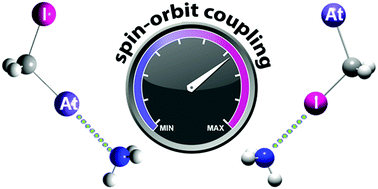Delocalized relativistic effects, from the viewpoint of halogen bonding†
Abstract
The ability of organic and inorganic compounds bearing both iodine and astatine atoms to form halogen-bond interactions is theoretically investigated. Upon inclusion of the relativistic spin–orbit interaction, the I-mediated halogen bonds are more affected than the At-mediated ones in many cases. This unusual outcome is disconnected from the behavior of iodine's electrons. The significant decrease of astatine electronegativity with the spin–orbit coupling triggers a redistribution of the electron density, which propagates relativistic effects toward the distant iodine atom. This mechanism can be controlled by introducing suitable substituents and, in particular, strengthened by taking advantage of electron-withdrawing inductive and mesomeric effects. Noticeable relativistic effects can actually be transferred to light atoms properties, e.g., the halogen-bond basicity of bridgehead carbon atoms doubled in propellane derivatives.



 Please wait while we load your content...
Please wait while we load your content...